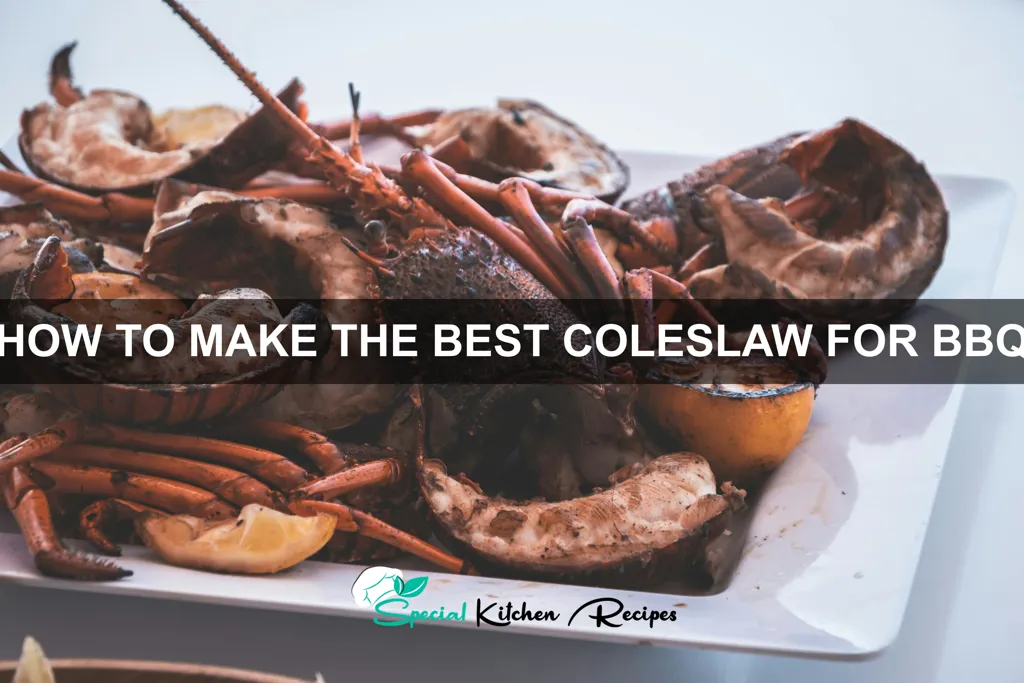Coleslaw, a vibrant and refreshing side dish, is a staple at countless barbecues and summer gatherings across the globe. Its origins are surprisingly murky, with various claims vying for its birthplace. While some point to the Netherlands, where shredded cabbage salads were common, others suggest a more direct lineage from the 18th-century American South, where enslaved people adapted European cabbage recipes into something uniquely their own. Regardless of its precise genesis, the evolution of coleslaw showcases the beautiful adaptability of food traditions, blending cultural influences to create a beloved dish.
The name itself, coleslaw, is a delightful blend of Dutch and English. Koolsla in Dutch translates directly to cabbage salad, reflecting its core ingredients. The dish’s popularity exploded in the United States during the 20th century, becoming a ubiquitous accompaniment to fried chicken, barbecue, and other hearty fare. In fact, according to a recent survey by the National Restaurant Association, coleslaw remains within the top five most popular side dishes served at restaurants across America. This enduring appeal speaks to its versatility and ability to complement a wide range of flavors.
Beyond its simple preparation, coleslaw holds a significant cultural place. For many, it’s not just a side dish; it’s a symbol of family gatherings, summer picnics, and the joy of shared meals. The creamy, tangy dressing, often featuring mayonnaise, vinegar, and a touch of sweetness, evokes a sense of nostalgia and comfort. Regional variations abound, reflecting the diverse culinary landscapes of North America and beyond. From the creamy, tangy Southern style to the lighter, vinegar-based versions popular in the Northeast, coleslaw offers endless possibilities for customization. Its adaptability allows everyone to tailor it to their personal preferences, making it a truly beloved addition to any barbecue spread.
Ingredients and Measurements
Creating the perfect coleslaw hinges on using fresh, high-quality ingredients and precise measurements. Don’t skimp on the details – they make all the difference!
For this recipe, we’ll be using approximately 1 medium-sized head of green cabbage (about 2 pounds). Choose a firm, crisp cabbage with no blemishes. Avoid cabbages that feel soft or have dark spots, as these can indicate spoilage. Properly washing the cabbage is crucial. Cut the cabbage into quarters and thoroughly rinse under cold running water, removing any loose outer leaves.
Next, you’ll need 2 medium-sized carrots (about 6 ounces total). Again, choose carrots that are firm and vibrant in color. Peeling the carrots is optional; however, for a smoother coleslaw, peeling is recommended. Use a vegetable peeler to remove the skin and then shred the carrots using a box grater or food processor fitted with a shredding disc. Aim for a consistent shred size for even cooking and texture.
The creamy dressing is where the magic happens. We’ll be using 1 cup of mayonnaise. Choose a high-quality mayonnaise for the best flavor. Don’t be tempted to substitute with a lighter version, as the richness of full-fat mayonnaise contributes significantly to the creamy texture and mouthfeel.
For tang and sweetness, we’ll incorporate 1/2 cup of apple cider vinegar. This provides a fantastic balance to the richness of the mayonnaise. Use apple cider vinegar, not white vinegar; the milder flavor of apple cider vinegar complements the other ingredients better.
To enhance the sweetness, we’ll add 1/4 cup of granulated sugar. Adjust this amount to your preference. Some prefer a sweeter coleslaw, while others prefer a more tart flavor profile. You can also substitute with honey or maple syrup for a more complex flavor.
Finally, for seasoning, we’ll use 1 teaspoon of salt and 1/2 teaspoon of black pepper. Taste and adjust the seasoning as needed. You might prefer more salt or pepper depending on your taste preferences. A pinch of celery seed or onion powder can also add a nice depth of flavor.
Remember to measure your ingredients accurately. Using a kitchen scale for the cabbage and carrots will ensure consistency. For the liquid ingredients, use measuring cups and spoons for precise measurements. Accurate measurements are essential for achieving the perfect balance of flavors and textures in your coleslaw.
Equipment and Utensils
Making a truly exceptional coleslaw requires the right tools. While you might be able to manage with a basic set, investing in a few key pieces will significantly improve your results, yielding a perfectly shredded slaw with a fantastically creamy dressing.
For optimal cabbage shredding, a mandoline slicer is highly recommended. Its adjustable blades allow for precise control over the thickness of your cabbage strips, ensuring a consistent texture throughout your coleslaw. If you don’t own a mandoline, a sharp chef’s knife (at least 8 inches) will suffice, but be prepared for a slightly more time-consuming and potentially less uniform process. Practice your knife skills to achieve even shreds; uneven pieces will lead to uneven cooking and dressing distribution.
A large mixing bowl, at least 5-quart capacity, is essential for combining the shredded cabbage, carrots, and dressing. A larger bowl is better than a smaller one; it allows for easier mixing and prevents the ingredients from overflowing during the tossing process. Choose a bowl made from non-reactive material such as stainless steel or glass to avoid any potential chemical reactions with the acidic elements in the dressing.
For the dressing, you’ll need a medium-sized bowl (approximately 3-quart) for whisking together the mayonnaise, vinegar, sugar, and seasonings. A whisk is preferred over a spoon or fork for achieving a smooth, emulsified dressing; it incorporates air effectively, creating a lighter texture. If you prefer a smoother, lump-free dressing, consider using an immersion blender for a few seconds after whisking.
Finally, you’ll need measuring cups and spoons for precise ingredient measurements. Accurate measurements are crucial for achieving the perfect balance of flavors in your coleslaw. A set of measuring spoons (1/4 teaspoon, 1/2 teaspoon, 1 teaspoon, 1 tablespoon) and measuring cups (1 cup, 1/2 cup, 1/3 cup, 1/4 cup) will ensure consistency in your recipe. Don’t forget a sturdy spoon or spatula for folding the dressing into the cabbage mixture.
While not strictly necessary, a colander or sieve can be helpful for rinsing the shredded cabbage before dressing, although this step is mostly for those who prefer a less intense cabbage flavor.
Vegetable Preparation (Washing, Shredding, Slicing)
The key to a fantastic coleslaw lies in the preparation of your vegetables. Crisp, clean vegetables are essential for optimal texture and flavor. For this recipe, we’ll be using approximately 1 medium-sized head of cabbage (about 2 pounds) and 2 large carrots (approximately 1 cup shredded).
Washing: Begin by thoroughly washing both the cabbage and carrots under cold running water. Remove any loose outer leaves from the cabbage and discard them. For the carrots, scrub the skins with a vegetable brush to remove any ingrained dirt. A thorough washing is crucial to eliminate any pesticides or soil residue.
Cabbage Preparation: Remove the core from the cabbage by cutting it out with a sharp knife. There are two main approaches to shredding the cabbage: using a food processor or shredding it by hand. For a consistently uniform shred, a food processor with a shredding disc is recommended. If using a food processor, pulse the cabbage in short bursts to avoid over-shredding and creating mushy cabbage. If shredding by hand, use a sharp knife and aim for thin, even ribbons of cabbage. Aim for approximately 10 cups of shredded cabbage after removing the core.
Carrot Preparation: Peel the carrots using a vegetable peeler. Similar to the cabbage, you can shred the carrots using a food processor or a grater. A box grater works well for creating fine shreds, while a food processor allows for quicker processing of larger quantities. If using a grater, be cautious to avoid grating your knuckles! For optimal texture, try to achieve a similar shred size to the cabbage. Approximately 1 cup of shredded carrots is ideal for this recipe.
Professional Tip: For the most vibrant color and crispness, avoid washing the shredded cabbage and carrots until immediately before adding them to the coleslaw dressing. Washing ahead of time can lead to wilting.
Important Note: The quantities of cabbage and carrots are suggestions; feel free to adjust them based on your preference. If you prefer a more cabbage-heavy coleslaw, increase the amount of cabbage accordingly. Similarly, if you enjoy a stronger carrot flavor, increase the amount of shredded carrots.
Dressing Preparation (Mixing, Emulsifying)
The success of your coleslaw hinges heavily on the creamy, flavorful dressing. This section details how to create a perfectly emulsified dressing that will coat your cabbage beautifully and prevent separation.
For this recipe, we’ll be making a classic mayonnaise-based dressing. Start with precise measurements to ensure consistent results. We’ll use:
- 1/2 cup mayonnaise (preferably high-quality, full-fat)
- 1/4 cup apple cider vinegar
- 2 tablespoons granulated sugar
- 1 tablespoon Dijon mustard
- 1 teaspoon celery seed
- 1/2 teaspoon salt
- 1/4 teaspoon black pepper
Begin by whisking together the vinegar and sugar in a medium bowl. This helps dissolve the sugar completely and creates a slightly acidic base for the emulsion. Don’t skip this step! It’s crucial for preventing the dressing from separating later.
Next, gradually add the mayonnaise to the vinegar mixture while whisking constantly. This slow incorporation is key to creating a stable emulsion. If you add the mayonnaise too quickly, the dressing may become lumpy or separate. The whisk helps to incorporate air and create a smooth, creamy texture.
Once the mayonnaise is fully incorporated, stir in the Dijon mustard, celery seed, salt, and pepper. Taste the dressing and adjust the seasoning as needed. You might want to add a little more sugar for sweetness, vinegar for tang, or salt and pepper for extra flavor.
For a smoother, creamier dressing, you can use an immersion blender. Simply add all the ingredients to a bowl and blend until completely smooth and emulsified. This method is particularly effective for incorporating the mayonnaise smoothly and achieving a silky texture.
Important Note: If you notice your dressing starting to separate after a few hours, simply whisk it vigorously again to re-emulsify it. This is normal for some mayonnaise-based dressings.
Once your dressing is prepared, it’s ready to be combined with your shredded cabbage and carrots. Enjoy your delicious homemade coleslaw!
Combining and Marinating
Once you’ve prepped all your coleslaw ingredients (see previous sections on shredding cabbage and preparing the dressing), it’s time to combine them and let the flavors meld. This marinating step is crucial for a truly exceptional coleslaw; it allows the cabbage to soften slightly and absorb the delicious dressing, resulting in a more flavorful and tender final product.
In a large bowl, preferably one with high sides to prevent spills during mixing, add your shredded cabbage. For a standard coleslaw serving 6-8 people, aim for about 6 cups of shredded cabbage. You can adjust this amount based on your needs. Next, add your shredded carrots. A good ratio is approximately 1 cup of shredded carrots to 6 cups of cabbage, but feel free to adjust to your preference.
Now, it’s time to introduce the dressing. Pour your prepared dressing (see the recipe in the previous section) slowly over the cabbage and carrots, ensuring that all the vegetables are evenly coated. Don’t be shy with the dressing; a well-dressed coleslaw is a happy coleslaw. However, avoid over-dressing, as this can lead to a soggy outcome. A good rule of thumb is to start with the full dressing amount specified in the recipe and add more only if needed.
Once the dressing is added, use two large spoons or your hands (ensure they are clean!) to gently toss the cabbage and carrots together until everything is thoroughly combined and coated. Avoid overly vigorous mixing, as this can bruise the cabbage and lead to a less appealing texture. Gentle, folding motions are best.
After combining, cover the bowl with plastic wrap or a lid and refrigerate for at least 30 minutes. This allows the flavors to meld and the cabbage to slightly soften. For an even more intense flavor, you can marinate the coleslaw for up to 2 hours, but avoid marinating it for longer periods, as the cabbage might become too soft and lose its desirable crunch.
Before serving, give the coleslaw one final gentle toss to redistribute the dressing. This ensures that even distribution of flavor and prevents the dressing from settling at the bottom. Serve chilled and enjoy your perfectly marinated, BBQ-ready coleslaw!
Chilling and Serving Your Coleslaw
Chilling your coleslaw is crucial for achieving the perfect balance of flavors and textures. A properly chilled coleslaw will have a crisp, refreshing bite that complements the richness of your BBQ fare. Never serve coleslaw at room temperature; it will become soggy and unappetizing.
Once you’ve thoroughly mixed your coleslaw, cover the bowl tightly with plastic wrap, pressing it directly onto the surface of the slaw to prevent the formation of a skin. This also helps retain moisture and prevent oxidation, which can dull the vibrant colors of your vegetables. Airtight storage is key for optimal freshness.
Refrigerate the coleslaw for at least 2 hours, and preferably 4-6 hours, or even overnight. This allows the flavors to meld together and the cabbage to chill thoroughly, resulting in a crisper texture. Longer chilling times are generally better, but after 24 hours, the cabbage may start to lose some of its crispness.
When you’re ready to serve, taste the coleslaw and adjust the seasoning if needed. You might find that the flavors have intensified after chilling, and a slight tweak to the vinegar or sugar might be necessary. Always taste before serving to ensure optimal flavor balance.
For serving, consider the presentation. A simple bowl works well, but you can elevate your presentation with a decorative serving bowl or even individual serving dishes. If using a large bowl, consider placing a bed of ice underneath the bowl to keep the coleslaw extra cold. This is especially helpful during warmer weather or if you’re serving a large quantity.
Avoid keeping the coleslaw at room temperature for extended periods. Bacteria can grow quickly in mayonnaise-based dressings, so it’s important to keep the coleslaw refrigerated until you’re ready to serve it. Discard any leftover coleslaw after 3-4 days for optimal food safety.
Garnish your coleslaw before serving for an extra touch of elegance. Chopped fresh parsley, chives, or even a sprinkle of paprika can add visual appeal and enhance the overall presentation. Remember, the best coleslaw is not only delicious but also visually appealing. A beautiful presentation enhances the dining experience.
Finally, remember that the serving temperature significantly affects the overall experience. A perfectly chilled coleslaw is a delightful contrast to the warmth of your BBQ, creating a truly memorable culinary adventure. Proper chilling is essential for a great coleslaw.
Recommendations for the Best BBQ Coleslaw
For the best flavor and texture, prepare your coleslaw at least 30 minutes before serving to allow the flavors to meld. This allows the cabbage to soften slightly and the dressing to permeate the slaw. If making ahead, refrigerate for up to 2 days, but avoid making it much further in advance as the cabbage can become overly soft.
Serving suggestions abound! Coleslaw is a classic BBQ side, so it pairs wonderfully with pulled pork, brisket, ribs, grilled chicken, or even hot dogs and hamburgers. Consider serving it in individual small bowls or cups for easy portioning and a more elegant presentation. You can also garnish with fresh herbs like dill or chives for an extra pop of flavor and visual appeal.
To enhance the overall dining experience, consider offering complementary dishes. A tangy coleslaw balances the richness of BBQ meats, so pairing it with something lighter, such as a simple green salad or corn on the cob, creates a well-rounded meal. Avoid serving coleslaw with other creamy or mayonnaise-based dishes to prevent an overwhelming richness.
Storage is crucial for maintaining freshness. Store leftover coleslaw in an airtight container in the refrigerator. It will generally keep for 3-4 days, but it’s best enjoyed within the first two. Do not freeze coleslaw, as the texture will be negatively affected upon thawing.
Nutritional Information (per serving, approximate): Calorie count will vary depending on the specific ingredients and quantities used, but a typical serving of coleslaw may contain approximately 200-300 calories. It’s a source of Vitamin C from the cabbage and fiber, but also contains fat and sodium from the dressing. Always check nutrition labels of your specific ingredients for a more accurate assessment.
Pro Tip: For a truly exceptional coleslaw, experiment with different types of cabbage (red cabbage adds color and a slight sweetness!), and consider adding other vegetables like shredded carrots or bell peppers. A squeeze of fresh lemon juice can brighten the flavors, and a pinch of celery seed adds a distinctive note.





